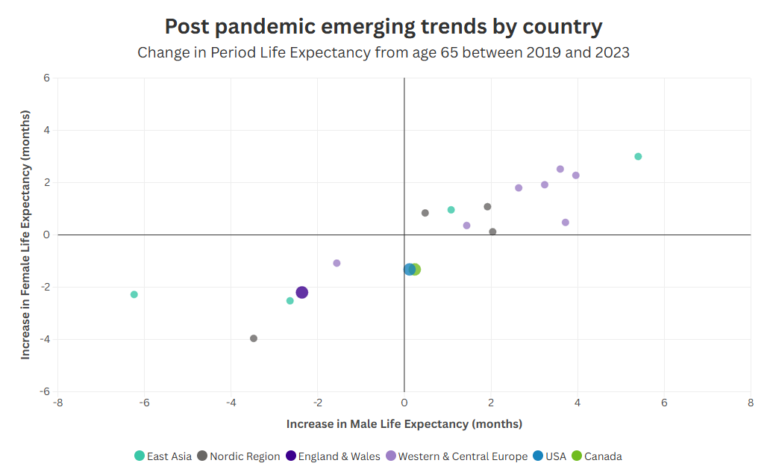Top Charts 25-09 – Post-COVID International Comparison
Question:
Are life expectances recovering post-COVID? What does the latest evidence suggest?
Answer:
As with many Top Chart questions, the answer is “it depends”... while many countries show modest increases in life expectancy since before the pandemic, some have experienced stagnation or decline.
Using data from the Human Mortality Database (HMD)1 , we have compared life expectancy in 2023 with that in 2019 across a range of countries for which data is readily available2. We looked at the increase (or reduction) in period life expectancy3 from age 654 for men and women.

Click here to view a larger interactive image
Most countries saw increases in life expectancy over the period among both men and women. The median increase was around one month for both men and women. However, the countries in which Club Vita operate appear to lag behind this trend:
In the US and Canada, male life expectancy has flatlined and female life expectancy has fallen by over a month.
In England & Wales, both male and female life expectancy has fallen by over two months.
Those countries are not the only poor performers, with Taiwan, Finland, Japan and Austria also seeing a fall in life expectancy for both men and women over the period5.
There are also some wider patterns across the three regions we have considered, with Western and Central Europe generally outperforming the Nordic countries, and with East Asia showing the highest level of variation. These differences could be due to a number of different factors such as different approaches to lockdown and social distancing, differing ramifications on health services post pandemic or different levels of vaccine take up.
Readers in the UK will be aware that 2024 was a more positive year for post-retirement longevity trends in England & Wales6. Period life expectancy from age 65 for men and women in 2024 was around one month higher than in 2019. While this is good news, it still falls below what several Western & Central European countries had already achieved by 2023.
Key takeaways
- 2023 is the first year for which we can reasonably assess post-COVID longevity trends.
- The early evidence is that Canada, the US and in particular England & Wales are not bouncing back from the pandemic as well as many comparator countries.
- There is a wide range of experience globally, with Western European countries (excluding England & Wales) generally doing consistently well.
- It takes time for population mortality data to be gathered, processed and published. It will therefore take a couple more years before we can see the full post-COVID longevity landscape.
The key questions are:
- Should we expect to see a further bounce back in the Club Vita populations during 2024 and 2025?
- Or do the US, the UK and Canada share common features which explain what we saw in 2023 and could lead to a continuing sluggish recovery from the pandemic?
What do you think?
1. Human Mortality Database. Max Planck Institute for Demographic Research (Germany), University of California, Berkeley (USA), and French Institute for Demographic Studies (France). Available at www.mortality.org (data downloaded on 12 September 2025).
2. We have only included countries who have published 2023 mortality data as of September 2025. However, in our view, the countries for which data is available represents a reasonable benchmark.
3. Life expectancies that are determined based on mortality rates for one particular period with no allowance for any future changes in mortality rates after that period – see Lexicon of Longevity.
4. In our work we often compare life expectancies from age 65 because it represents a more relevant measure for pension plans than the commonly used life expectancy from birth statistic - see Club Vita | UK | Misleading headlines
5. Other countries shown on the chart are Belgium, Switzerland, Denmark, Spain, France, Hong Kong, Republic of Korea, Norway, Poland, Portugal and Sweden. Some countries with very small populations were excluded.
6. We have only considered period life expectancies from age 65 in this article. Further details on the change in mortality rates in England & Wales between 2019 and 2024 for different age groups can be found in our previous article – see Club Vita | UK | Top Charts 25-01





